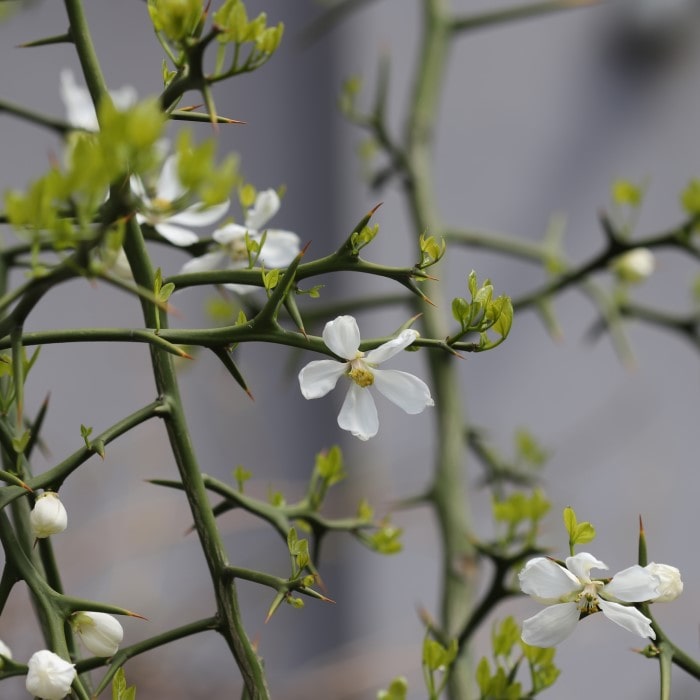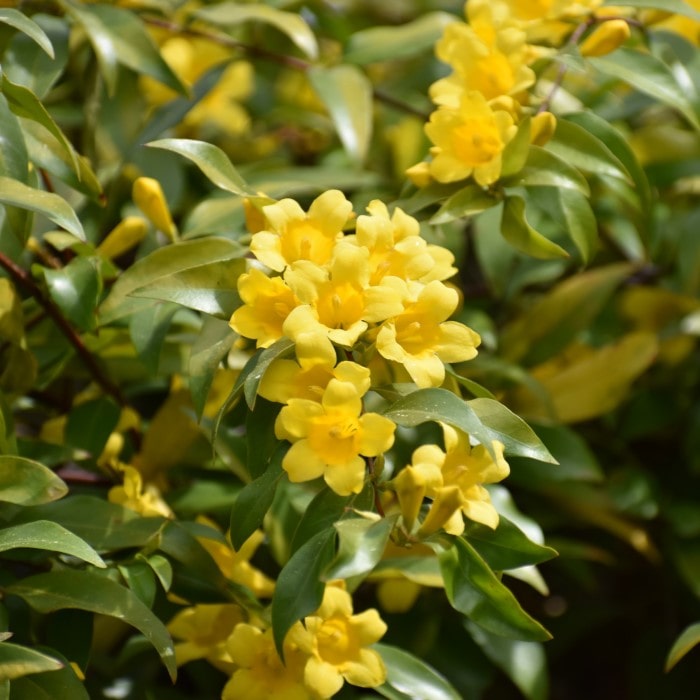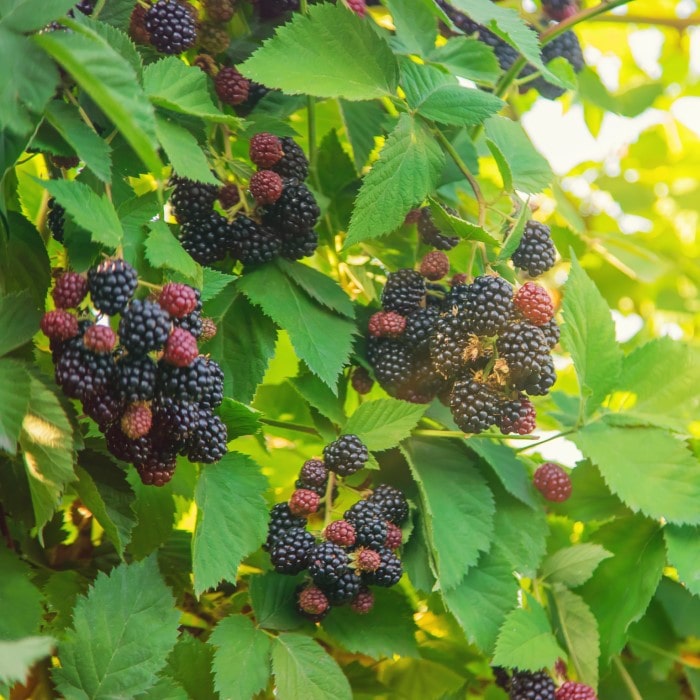Nematanthus gregarious
Overview
Uses: Houseplant, patio plant, or outdoor plant (in approved tropical zones)
Benefits: Non-toxic and perfect for areas that other plants may pose a risk to pets and children. Air purifier—removes formaldehyde, benzene and carbon monoxide while also helping eliminate odors. Beautiful flowers that resemble goldfish.
USDA Hardiness Zones: 11 - 12 suggested (may have mixed success in zone 10)
Sun: Bright Indirect. Avoid strong, full sun.
Life Cycle: Perennial
Mature Height: 18" (beyond this height branches will typically begin to hang)
Mature Width: 6' (branches may trail up to 3' from the base, but are easily kept shorter by trimming)
Summary
The Goldfish Plant is a tropical succulent-like plant within the Gesneriaceae family.
Growing up to 18" high with trailing branches up to 48" long and covered in thick, shiny, dark green leaves, they are best known by and named after their unique reddish orange, tubular flowers that resemble a goldfish.
Typically blooming profusely throughout spring and summer (possibly all year under ideal conditions), they're great and colorful houseplants for either a table or a hanging basket.
No need to worry about too much with this nontoxic, and low maintenance live indoor plant—just be sure keep it in an area with lots of bright, indirect light and to keep its soil moist.
Care
How to Water a Goldfish Plant
We suggest generously watering an indoor Nematanthus gregarious every 3-5 days between spring and fall in an attempt to keep its soil moist at all times.
The plant will likely not drink as much during winter, at which time it's suggested to shift the frequency of watering to a weekly schedule—not allowing the soil in the pot to completely dry between watering.
Like many other plants, too much watering will result in the yellowing of stems and leaves, eventually followed by root rot should the wet conditions persist.
Goldfish Plant is considered to be drought resistant, but too little water will eventually result in the browning of branches and leaves, ultimately followed by the death of the plant if the dry conditions persist.
What is the Best Humidity for a Goldfish Plant?
Nematanthus gregarious prefers moderate to high levels of humidity (greater than 50% RH).
It appreciates misting during periods of drier air; however, misting too frequently can cause fungal issues. Always mist with room temperature water as cold water may damage the plant.
Humidifiers and pebble beds may be used to supplement humidity in dry locations.
How Much Sun Does a Goldfish Plant Need?
Nematanthus gregarious likes lots of weak, indirect sun and does best in areas that receive extended periods of such light, like an eastern facing window or curtained southern window.
Avoid placing this plant in areas that receive extended periods of strong, direct sunlight, which could cause leaf burn and damage flowers.
Too little light will result in a lack of flower production, gangly stems, poor growth, and possible death.
What Temperature is Best for a Goldfish Plant?
Nematanthus gregarious prefers warmer temperatures and will likely die in extended periods of 50°F weather.
It's best to keep this plant in temperatures above 55°F to ensure its beauty and the integrity of its growth; however the optimal temperature range of this houseplant is between 65°F and 85°F.
As such, Goldfish Plant thrives outdoors year round in USDA zones 10-11, and will likely not survive living outdoors over winter in USDA zone 9 or cooler.
How to Fertilize a Goldfish Plant
Nematanthus gregarious should be fertilized on a regular basis between early spring and late fall, especially during periods of new growth.
We suggest using a balanced liquid fertilizer (like a 20-20-20), our balanced slow release fertilizer (13-11-11), or a fish emulsion that has been diluted to 50% strength to decrease the potential of overfertilization/burning.
You may also use a fertilizer high in phosphorous (like a 10-30-20) to encourage/maintain blooming.
What Type of Soil Do Goldfish Plants Like?
Nematanthus gregarious isn't too picky when it comes to soil.
We suggest soil that is loose, rich, and well-draining. Our potting soil is a great option for anyone planting their Goldfish Plants in pots.
Trimming and Maintenance of Goldfish Plant
It's suggested that you trim your Nematanthus gregarious on an annual basis to keep it looking its best.
Trimming is best done after the flowering cycle, and is accomplished with the use of a clean and sharp trimming scissors.
Stems may be cut as close to 8" from the soil if desired, and it's advised to only cut them to a maximum of 1/3 of their length. This method will result in a plant that is bushy, attractive, and healthy.
We suggest lightly fertilizing after any extensive pruning.
A bushy and healthy plant can be also be encouraged by trimming or pinching new growth from the tips of the stems once they reach their desired length, which will signal the plant to sprout lower growth.
Like most other plants, it's advised that any dead or dying stems and leaves be removed from the plant to keep it as healthy and sanitary as possible. Flowers should be removed as soon as they are finished.
How to Repot a Goldfish Plant
Nematanthus gregarious does well slightly rootbound but does not do well when tightly rootbound so it's suggested that you repot your plant if its roots begin to really crowd its pot or begin to emerge from the drain holes. Doing so will greatly extend the lifespan of your plant. The growth rate of this plant typically requires repotting and/or root pruning about every two years. You can repot your plant by placing the entire root ball into a larger pot then softly breaking up its root structure around the edges of its root ball prior to surrounding it with a lightly packed, medium porosity potting mix. It's advised to only slightly increase the pot size when repotting.
In situations of root bounding without the desire for a larger pot and/or plant, it's advised to remove your Goldfish plant from its pot and to trim away the side/lower roots with a clean, sharp knife and to replace their space with new, rich potting soil.
How to Propagate a Goldfish Plant
The propagation of Nematanthus gregarious is easily accomplished through the use of cuttings. You'll want to make sure your cutting is taken from a plant that is not in the flowering phase, which means you'll likely be pulling your cutting in the late summer through winter.
Goldfish Plants have a tendency to rot during propagation, so we don't suggest propagating in water.
It's best to place the cutting in slightly moist soil and to place it in an area that receives lots of indirect sunlight. Mist the cutting daily and try to keep the humidity it's in around 75+%. Don't keep the soil too wet or your cutting will rot instead of grow roots. With any luck, you'll have roots in about 2 weeks.
We suggest the use of humidifiers, humidity domes, and bottom heat to aid the rotting/propagation process.
Size
What Size Goldfish Plants are for Sale Online?
The Nematanthus gregarious that we sell online will ship in a greenhouse grade grow pot or hanging basket. Each plant will be appropriately sized for its pot. Please contact us with any specific questions.
How Large Do Goldfish Plants Grow?
The size of Nematanthus gregarious at maturity is typically no larger than 18" high and 48" wide.
Additional Information
Common Names of Nematanthus gregarious
-
Goldfish Plant
-
Clog Plant
-
Guppy Plant
Toxicity and Risks of Goldfish Plant
Nematanthus gregarious is considered safe and nontoxic for both pets and people. 














